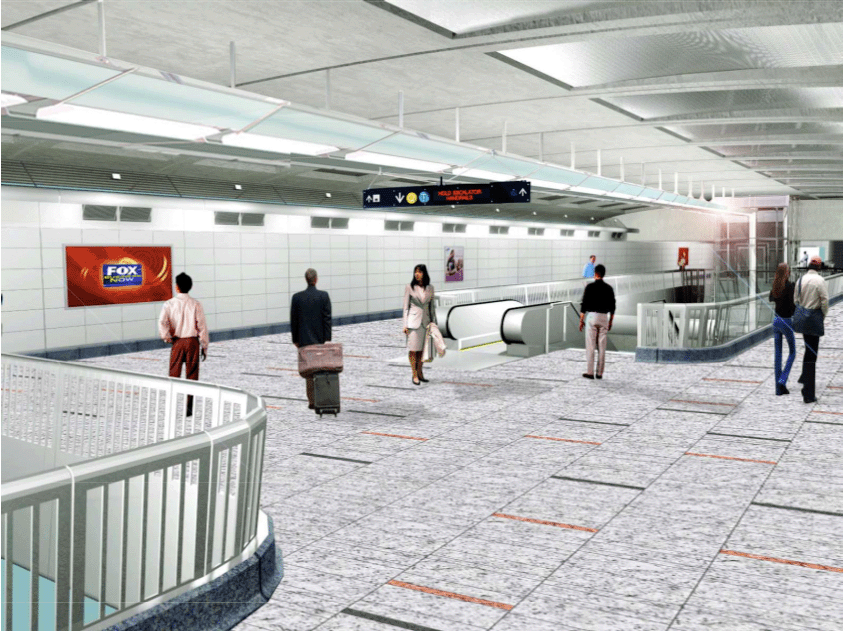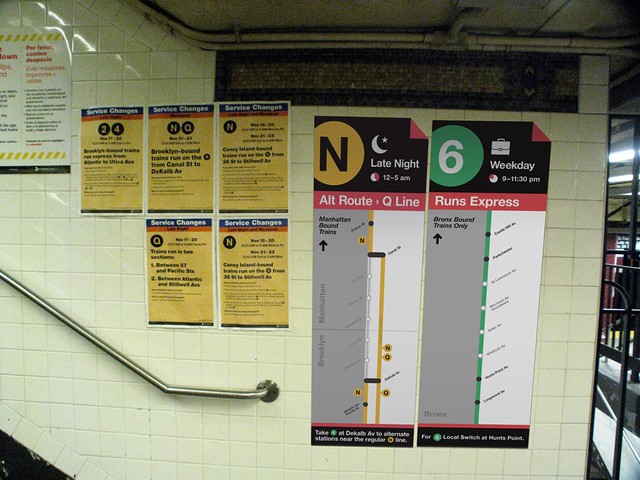Actually, because the 7 line extension had the pleasure of two tunnel boring machines digging at once, this post should probably be called “A tale of three TBMs,” but the literary reference just isn’t the same. Anyway, I digress.
This evening, I found myself walking south from 46th St. on 10th Ave. heading to meet some friends in the West Village. As I walked past the 41st St. area, I did an informal survey of the area and counted at least five buildings either brand new or under construction as well as countless other developments that were just a handful of years old. These were the buildings housing the residents who would stand to benefit with a station at 10th Ave. and 41st St. Maybe REBNY can deliver for them after all.
Little did I know that, a few hours earlier, New York City officials had gathered underground near that very same spot to celebrate a milestone. The second of the two tunnel boring machines working its way from 11th Ave. and 34th St. to 41st St. west of 8th Ave. had broken through the tunnel wall. With the other TBM reaching its destination in mid-June, the boring for the 7 line extension is complete, and now the finishing work can begin.
Shortly after 4 p.m. this afternoon, the TBM reached its destination, and Mayor Michael Bloomberg, MC-ing the ceremony because the city’s billions are funding the project, toasted the progress. “It will bring us one step closer to the moment about three years from now when the number 7 train will stop at Times Square and then continue on to the new 34th Street station on the Far West Side,” he said. “And that moment will be the culmination of all of our efforts to realize the full potential of the Far West Side and revitalize an area of the city with new business and new residents and parks and open spaces.” Despite these lofty goals, the second station for this $2.1 billion expansion remains in limbo.
For the MTA, yesterday’s ceremony marked the end of a 13-month period of digging, and the MTA is ahead of the schedule. The boring, which was supposed to last 2-3 years, took six months due to cooperation between the MTA and Port Authority. With only the stations to construct and the ventilation infrastructure to build, the MTA and City are racing the clock. Will the 7 extension be open before Mayor Bloomberg’s third term is up?

A shot of Second Ave. at 90th St. where a drill probe punctured the street. Photo courtesy of The Launch Box.
Meanwhile, across town, the boring underneath Second Avenue has faced its own set of challenges. Progress, as we know, has not be swift, and a little over a week ago, crews ran into a bump in the road with a drill probe popped through the streets of Second Ave. Ben Heckscher over at The Launch Box wrote an extensive post on the incident. Here’s his retelling of the vital bits:
A drill that was connected to the Second Avenue subway TBM went off course at about 3 a.m. [on July 8] and broke through the surface of 2nd Avenue at East 90th Street.
No injuries were reported and luckily the drill did not pierce the 30-inch gas main, the 36-inch water main or any of Con Edison’s cables below the surface of Second Avenue in this area. If the drill had pierced a gas main, the consequences clearly could have been tremendous.
During the TBM mining operation, which is taking place about 60 feet below street level, the sandhogs perform a process known as “probing” using a rock drill to determine ground conditions and water inflows ahead of the TBM. Apparently one of the probes that they drilled went in an unintended direction and ended up bursting out into the open air at East 90th Street.
I spoke to Kevin Oritz at the MTA shortly after the incident, and Ortiz told me that the authority had asked the contractos to cease probe drilling while the authority investigates the accident. “We don’t anticipate this to have an impact on completing of the first run of the TBM before the end of the year,” he told me.
Still, there are real and legitimate concerns at play. South of the Launch Box and north of the 86th St. station, the MTA has not relocated utilities, and city records do not paint an accurate portrait of the goings-on underground. As Heckscher pointed out, had the drill probe ruptured the gas line, the subsequent explosion would have been catastrophic. The Upper East Side is lucky indeed that the probe drill missed these vital arteries.
And so slowly onward churn the TBMs underneath Second Ave. As the 7 line extension moves ahead on schedule, the SAS project lumbers forward with an unknown timeframe and drilling incidents that stymie progress.



 When it comes to problems plaguing the MTA, billions of dollars of debt isn’t exactly a sexy topic. On the surface, it doesn’t impact people’s lives as service cuts do, and it has little to do with the public mistrust of MTA management. Yet, whether riders realize it or not, the price we pay today in fare hikes and service cuts all comes back to debt.
When it comes to problems plaguing the MTA, billions of dollars of debt isn’t exactly a sexy topic. On the surface, it doesn’t impact people’s lives as service cuts do, and it has little to do with the public mistrust of MTA management. Yet, whether riders realize it or not, the price we pay today in fare hikes and service cuts all comes back to debt.
 When
When  Later this evening, MTA Board members and angry union members will square off in a pair of public hearings. Despite voting to cut the station agents in early 2010 and holding hearings on a nearly identical proposal a year ago, the MTA had to host these public open houses to placate a Manhattan Supreme Court judge who found that the MTA’s dismissals this year for plans approved last year violated the law. What the hearings tonight will accomplish is very little.
Later this evening, MTA Board members and angry union members will square off in a pair of public hearings. Despite voting to cut the station agents in early 2010 and holding hearings on a nearly identical proposal a year ago, the MTA had to host these public open houses to placate a Manhattan Supreme Court judge who found that the MTA’s dismissals this year for plans approved last year violated the law. What the hearings tonight will accomplish is very little.
 Posters proclaiming the various weekend service changes have long vexed the MTA. Once upon a time, the posters were a stark of black, white and red with some information tossed all over the place. In mid-2007, the authority
Posters proclaiming the various weekend service changes have long vexed the MTA. Once upon a time, the posters were a stark of black, white and red with some information tossed all over the place. In mid-2007, the authority